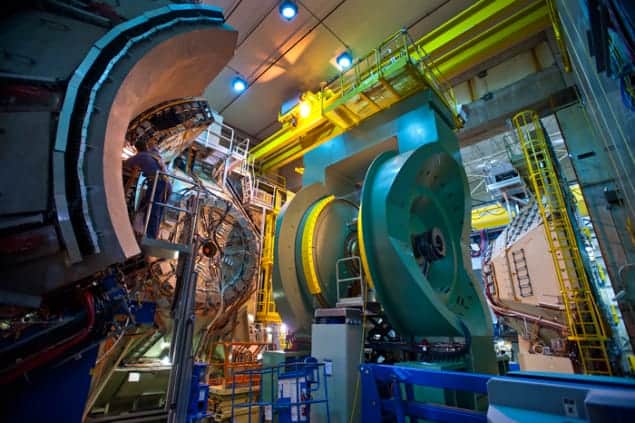
For a quarter of a century, physicists have faced a paradox regarding the net spin of protons and neutrons – the spin of their constituent quarks accounts for only a small fraction of their overall spin. Now, new research carried out by physicists in Argentina and Germany who have analysed data produced by the Relativistic Heavy Ion Collider (RHIC), suggests that the missing spin might come from gluons that hold quarks together.
Misplaced spins?
Spin, an intrinsic angular momentum, is a property of both protons and neutrons (collectively known as nucleons). Until the 1980s, physicists had assumed that the spin-1/2 of both the neutron and the proton was simply the sum of the spin-1/2 of their three constituent quarks – with two quarks spinning in the opposite direction to the third. But a series of experiments found that the quark spins contributed only a small fraction to the nucleon spins, leading to what was known as the “spin crisis”. Those experiments involved firing spin-polarized beams of electrons or muons at targets containing spin-polarized nucleons. The idea was to compare the deflection of the particles in the beam when their spin axis was pointed in the same direction as the beam with those in the opposite direction. The results of these scattering experiments showed that no more than about 25% of nucleon spin comes from the constituent quarks, meaning that physicists could not determine where protons and neutrons get their net spin.
One possibility lay with gluons that hold quarks together and are exchanged by quarks in strong-force interactions. As the experiments studying quark spin cannot measure the properties of gluons, which do not interact electromagnetically, researchers turned to RHIC. Situated at the Brookhaven National Laboratory near New York, it collides two beams of protons – the gluon from one proton can interact with the quark in another via the strong force.
Gyrating gluons
In the latest work, a group of theorists – Daniel de Florian, from the Aires University in Argentina, and colleagues – analysed several years’ worth of collision data from RHIC’s STAR and PHENIX experiments. De Florian and colleagues have now studied data collected up until 2009, and have compared those data with a theoretical model they have developed that predicts the likely spin direction of gluons carrying a certain fraction of the momentum involved in the proton collisions.
The researchers discovered, in contrast to a null result they obtained using fewer data five years ago, that gluon spin does tend to line up with that of the protons, rather than against it. In fact, they estimate that gluons could supply as much as half of a proton’s spin. “This is the first evidence that suggests gluons could make a significant contribution to proton spin,” says team member Werner Vogelsang of Tübingen University in Germany, who adds that, on theoretical grounds, gluons ought to supply the same amount of spin to neutrons.
Dizzy orbits
Vogelsang cautions that he and his colleagues cannot be sure of their result because they have not yet analysed the possible spin contribution of gluons with low momenta. Doing so, he says, will require data from higher-energy collisions at RHIC, where proton energies have recently been increased from 100 to 250 GeV, and potentially from a new generation of very-high-energy electron–proton colliders. These advanced machines might also allow physicists to study another possible source of nucleon spin – the orbital, as opposed to spin, angular momentum of quarks and gluons – an analysis that requires the measurement of extremely rare collision outcomes.
Robert Jaffe of the Massachusetts Institute of Technology in the US praises De Florian and co-workers for their “fine work”, saying that their research is an “important step” in understanding what makes up a proton’s spin. He adds that it makes it even more important for physicists to understand why the three-quark model of the proton works so well in describing properties such as the magnetic moment and yet falls so far short in the case of spin.
The research is published in Physical Review Letters.



